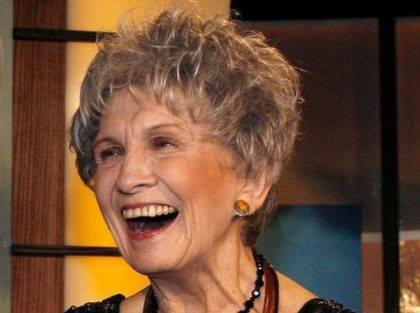Nelsonites have extra reason to take pride in Alice Munro’s recently-announced Nobel prize for literature: in 1973, she taught at the city’s Notre Dame University.
The acclaimed Canadian short story writer’s brief stint here was a turning point in her life, according to Robert Thacker in Alice Munro: Writing Her Lives: A Biography (2011). Munro came to Nelson from Victoria to teach a summer creative writing course as her first marriage was dissolving.
“Notre Dame was well away from Victoria and indeed from just about anyplace else,” Thacker writes.
Munro had by then published Dance of the Happy Shades (1968), which won the Governor General’s Award for Fiction, and Lives of Girls and Women (1971).
She accepted the job in March, which involved teaching the creative writing portion of an English class. A visiting UBC instructor taught the other half. The class met daily for two hours from July 23 to August 17 and Munro was paid $425 (about $2,100 today) plus a $70 travel allowance and a three-room apartment.
Drawing on this experience, she wrote multiple versions of an unpublished story called Creative Writing, several fragments of which survive. One passage reads:
“Dorothy teaches creative writing. She is not qualified to teach anything else. This is the summer school session, at a little college in the Kootenay mountains.”
In another draft, her surrogate Nellie speaks to English department head Dahlia as they head up a steep hill:
“‘Why did you come?’ said Dahlia. ‘Just out of curiosity?’
“My husband and I are splitting up,” Nellie said. ‘I wanted to get away somewhere for a while and it seemed like — I remembered driving through here once and I thought it was a nice place, with the lake —’”
According to Thacker, while Munro changed certain details in the various drafts, the teacher’s situation remained the same: “[T]he people at the college cannot believe anyone would come for the money they paid, she is working in ‘the smallest, dingiest and — it is now July — the hottest university in the world’ and she ‘is delighted’ because she ‘has never had an office or a job before.’”
Munro, who turned 42 in Nelson, came with her three daughters. Her eldest Sheila — who later wrote a memoir about her mother — worked in construction.
“[Alice] had her own place, and she knew she was out of her marriage,” Thacker wrote. “No longer dependent, she was on her own. She found the teaching difficult because of her shyness but, more than that, as a person who has little belief in such programs Munro felt like a fraud as she was doing it.”
But she was happy and met people through the university, which raised her profile. “So the summer she spent in Nelson proved to Munro that, like her narrator in Red Dress – 1946, her new life was possible,” Thacker wrote.
Once her teaching stint concluded, Munro moved to Ontario.
Retired university librarian Ron Welwood has a faint memory of meeting Munro in Nelson. “She was rather shy, reserved and very polite,” he says.
Munro returned here in March 1984 to read at David Thompson University Centre, the former Notre Dame.
Sheila also returned to Nelson and worked at Otter Books when it first opened, exactly a decade ago next month. Proprietor Letty Bartels says Sheila literally volunteered her services and stayed about six months.
Bartels had a bit of a personal connection with the family: growing up in Victoria, her parents knew Alice and first husband Jim.
This week Nelson city council passed a resolution to send a letter of congratulations to Munro, acknowledging her time here.
She isn’t the only famous writer to teach at a local post-secondary institute. Nelson-raised Fred Wah, Canada’s Parliamentary Poet Laureate, was an instructor at David Thompson University and Selkirk College.
Nelson writer adapted Munro’s work for TV
Among a number of Nelson connections to Alice Munro, local playwright Kelly Rebar (pictured below, courtesy screened.com) has adapted the Nobel-winning author’s work for television.
The initial assignment came in the mid-1980s when Rebar was part of the National Screen Institute. She wrote a screenplay for Munro’s short story Red Dress – 1946 and was hired the following year by the National Film Board and Atlantis Films who were co-producing Munro’s story Chaddeleys and Flemings: The Connection. A decade later she adapted Lives of Girls and Women for CBC.

“All her stories, or almost all, lend themselves to film,” Rebar says. “The material was so rich and lovely and pleasant to work with. A delight from beginning to end.”
At the same time, the structure of Munro’s stories, which stand on their own, but are often intertwined within a collection, posed some challenges: “I remember it being very tricky to get the timeline established and write it to everybody’s satisfaction.”
Rebar didn’t speak to Munro at any point during the process.
“Once she signed over the work, she gave full control to the production company. She may have chatted with the producers and directors about her take on the material, but she wanted to keep arm’s length from it.”
But the two writers did meet when Rebar’s play Bordertown Cafe was staged in Blyth, Ontario, not far from Munro’s home in Clinton. “All the adjectives used to describe her — approachable, down-to-earth, kind and so on — I found to be true.”
Rebar, who has a signed copy of one of Munro’s books, says she was “absolutely delighted” to hear of the Nobel win during a trip with her father, who relayed the news. “He was quite excited too. It’s such a lovely feeling to know she was honoured this way at this stage of her life.”
